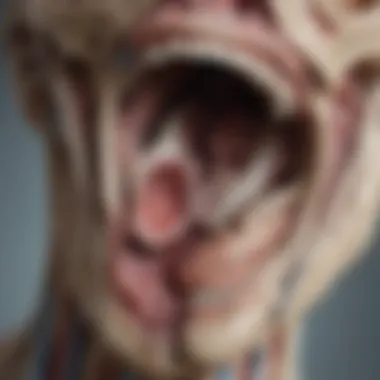Foramen Magnum Stenosis: An In-Depth Exploration


Intro
Foramen magnum stenosis involves the narrowing of the foramen magnum, a critical anatomical structure connecting the brain and spinal cord. This condition can lead to significant neurological implications, affecting an individual's overall health and quality of life. Understanding the etiology, symptoms, diagnostics, and treatment approaches is essential for medical professionals and researchers interested in neurology and anatomy.
This exploration prompts a closer look into the multi-faceted nature of foramen magnum stenosis, examining not only its anatomical aspects but also the clinical practices involved in managing it. The interplay of disciplines such as surgery and neurology further reveals how complex this condition is.
By diving into the relevant research, we aim to equip readers with updated information and insights into foramen magnum stenosis and its broader impacts.
Preamble to Foramen Magnum Stenosis
Foramen magnum stenosis is a significant medical condition that garners attention due to its implications on neurological health. This narrowing at the base of the skull affects the area where the spinal cord connects to the brain. Understanding this condition is vital for several reasons. Firstly, it has a direct impact on the central nervous system, potentially leading to serious health issues.
The examination of foramen magnum stenosis encompasses its anatomical aspects, symptoms, and implications on patient quality of life. By exploring these elements, healthcare professionals can better identify and treat the condition, ultimately improving outcomes for those affected.
Definition of Foramen Magnum Stenosis
Foramen magnum stenosis refers to the constriction or narrowing of the foramen magnum, the opening in the skull through which the spinal cord passes. This narrowing can result in increased pressure on the spinal cord and surrounding structures, often leading to a variety of symptoms. The severity and specific effects of this condition can vary significantly depending on the degree of stenosis and the underlying cause.
Anatomical Considerations
The foramen magnum is a critical anatomical feature located at the base of the skull. It is surrounded by important structures, including the occipital bone and the cervical spine. This area serves as a conduit for neural and vascular elements connecting the brain with the body.
In normal conditions, the foramen magnum provides adequate space for the spinal cord and associated ligaments. However, when stenosis occurs, the space is substantially reduced, which can lead to a range of clinical syndromes. The understanding of the anatomical geography surrounding the foramen magnum is paramount for diagnosing and devising treatment plans for stenosis.
Etiology of Foramen Magnum Stenosis
Understanding the etiology of foramen magnum stenosis is crucial in addressing this condition effectively. The origin of the stenosis impacts both symptoms experienced by the patients and the treatment options available. The etiology encompasses a variety of factors, including congenital issues, acquired conditions, and genetic predispositions. By analyzing these elements, healthcare professionals gain insights into potential interventions and management strategies.
Congenital Factors
Congenital factors play a significant role in the development of foramen magnum stenosis. Many patients are born with anatomical anomalies that affect the size and shape of the foramen magnum. Common congenital disorders include Chiari malformation, where brain tissue extends into the spinal canal, and any form of abnormal vertebral development.
These congenital conditions often lead to the narrowing of the foramen magnum, obstructing normal cerebrospinal fluid (CSF) flow and compressing the spinal cord. This pressure can result in neurological symptoms which may vary from mild discomfort to severe complications affecting mobility and coordination.
Acquired Conditions
Acquired conditions contribute significantly to the etiology of foramen magnum stenosis. These may arise from a variety of factors during an individual’s life. Traumatic injuries, such as fractures or dislocations of the cervical spine, can alter the structural integrity of the bone surrounding the foramen magnum, inducing narrowing over time.
Additionally, conditions such as osteoarthritis or inflammatory diseases can erode bone and lead to stenosis. Tumors, either benign or malignant, may also develop in the vicinity of the foramen magnum, causing compression. This highlights the importance of evaluating individual medical histories and conducting comprehensive diagnostic assessments.
Genetic Predispositions
Genetic predispositions also have a notable impact on the occurrence of foramen magnum stenosis. Certain genetic conditions might not only result in anatomical variations but can also influence the growth patterns of craniovertebral junction structures.
For example, conditions like Down syndrome or other syndromic disorders can lead to abnormalities in the atlas or occipital bone, increasing the risk of developing stenosis. Genetic counseling may provide additional information for families with a history of such conditions, underscoring the role of genetics in understanding this complex condition.
"The interplay between congenital, acquired, and genetic factors creates a multifaceted picture of foramen magnum stenosis that requires careful consideration when diagnosing and treating patients."
In summary, the etiology of foramen magnum stenosis encompasses a spectrum of factors that must be understood in totality to offer effective treatment and improve patient outcomes.
Clinical Presentation of Foramen Magnum Stenosis


Understanding the clinical presentation of foramen magnum stenosis is crucial for accurate diagnosis and effective treatment. The signs and symptoms that characterize this condition can vary among individuals and may not always be immediately evident. Recognizing these clinical manifestations aids healthcare professionals in making informed clinical decisions. This exploration also highlights the significance of early diagnosis in preventing further complications.
Common Symptoms
Foramen magnum stenosis has various symptoms, many of which stem from spinal cord compression. Some common symptoms include:
- Neck pain is often persistent and may radiate towards the shoulders.
- Numbness or tingling in the limbs is a frequent complaint, suggesting nerve involvement.
- Weakness in the arms or legs, which can progress over time, may indicate increasing pressure on the spinal cord.
- Difficulty with balance and coordination can occur, complicating mobility and increasing fall risk.
- Headaches, particularly at the back of the head, have been reported by many patients.
- In more advanced cases, severe cases of dizziness or vertigo may arise.
It is essential to understand that these symptoms can overlap with various other conditions. Thus, a careful evaluation is necessary to establish the underlying cause.
Symptom Progression
The progression of symptoms can vary significantly from one patient to another. Typically, individuals may first experience mild discomfort that intensifies over time. Many report that symptoms become more pronounced with activities like bending the neck or physical exertion. As the condition worsens, the severity and frequency of symptoms might increase.
- Initially, symptoms may present as mild neck pain or occasional tingling.
- In the following stages, patients might notice pronounced weakness and coordination issues.
- Finally, in severe cases, paralysis or significant loss of sensory and motor function can occur.
Consistent monitoring of these symptoms is important. Patients should be encouraged to report any changes to their healthcare providers immediately. This is crucial for timely interventions.
Differential Diagnosis
Given the overlapping symptoms with other neurological diseases, differential diagnosis is vital to accurately identify foramen magnum stenosis. Conditions that may present similarly include:
- Cervical spondylotic myelopathy
- Multiple sclerosis
- Spinal tumors
- Herniated discs
- Amyotrophic lateral sclerosis (ALS)
A thorough history and physical examination may guide clinicians in distinguishing these disorders. Diagnostic imaging plays an essential role in this process as well, often serving as a critical component for confirming the diagnosis of foramen magnum stenosis.
The timely recognition of symptoms can directly influence treatment outcomes and overall quality of life for patients suffering from this condition.
Diagnostic Approaches
Diagnostic approaches to foramen magnum stenosis are crucial within the context of this article. These methods provide essential information for identifying and evaluating this complex condition. An accurate diagnosis is vital for effective treatment planning and management.
Medical Imaging Techniques
Magnetic Resonance Imaging (MRI)
Magnetic Resonance Imaging (MRI) is an important tool in diagnosing foramen magnum stenosis. This imaging technique uses strong magnetic fields and radio waves to create detailed images of soft tissues, which include the brain and spinal cord. One of the key characteristics of MRI is its ability to provide clear images of both bone and soft tissue structures. This makes it a beneficial choice for assessing the anatomy and any associated abnormalities in the foramen magnum region.
Additionally, the unique feature of MRI is the lack of ionizing radiation, offering a safer option for patients, especially in cases requiring repeated imaging. Some disadvantages include higher costs and longer scanning times compared to other imaging modalities.
Computed Tomography (CT)
Computed Tomography (CT) plays a significant role in evaluating foramen magnum stenosis. This imaging technique uses X-rays taken from various angles to create cross-sectional images of the body. A key characteristic of CT is its speed in producing images, making it a popular choice in emergency settings.
CT scans excel in visualizing bony structures, which is beneficial for identifying osseous abnormalities causing stenosis. However, its unique downside is the exposure to ionizing radiation. The images may also not be as detailed regarding soft tissues when compared to MRI.
X-rays
X-rays are a basic yet essential imaging technique utilized in the assessment of foramen magnum stenosis. They produce images that help in evaluating the structure of bones. A key characteristic of X-rays is their accessibility and quick results, which makes them a reasonable starting point in the diagnostic process.
However, foramen magnum stenosis may not always be visible on X-ray images, as they provide limited information about soft tissues. Therefore, while X-rays are advantageous for initial assessments, further imaging techniques like MRI or CT may be necessary for a comprehensive evaluation.
Neurological Assessment


Neurological assessments further help in diagnosing foramen magnum stenosis. These assessments involve a series of tests to evaluate the function of the central and peripheral nervous systems. A healthcare professional will examine reflexes, muscle strength, coordination, and sensory responses. Identifying abnormalities in these areas can provide additional clues about the presence and severity of stenosis.
Electrophysiological Studies
Electrophysiological studies are sophisticated tests used to assess the electrical activity of nerves and muscles. These studies can be particularly valuable in understanding the functional impact of foramen magnum stenosis. For example, nerve conduction studies measure how well electrical signals are transmitted through the nerves, while electromyography evaluates the electrical activity in muscles.
This information can reveal potential nerve damage or dysfunction caused by stenosis, thus guiding treatment objectives.
In summary, accurate diagnostic approaches are essential in managing foramen magnum stenosis effectively. Medical imaging techniques, neurological assessments, and electrophysiological studies work together to provide a well-rounded understanding of the condition.
Treatment Options
The options for treating foramen magnum stenosis are critical to improving patient outcomes. As this condition can significantly affect a person's quality of life and neurological function, it is essential to evaluate both conservative and surgical approaches. The strategies selected depend on the severity of stenosis, patient health, and specific symptoms presented. Each treatment option offers varied benefits and has its challenges that medical professionals consider when creating a comprehensive treatment plan.
Conservative Management
Conservative management often serves as the first line of treatment for foramen magnum stenosis. This approach primarily aims to relieve symptoms and improve functionality without immediate invasive procedures.
Physical Therapy
Physical therapy plays a vital role in conservative management for patients with foramen magnum stenosis. This approach may involve tailored exercise routines targeting strength, flexibility, and coordination. The key characteristic of physical therapy is its non-invasive nature, making it a beneficial choice for many patients seeking to avoid surgery. A unique feature of physical therapy is that it helps patients learn proper movement patterns, reducing strain on the spinal structures.
The advantages of physical therapy include improved muscular support and enhanced mobility. However, it may not provide complete relief for all patients, especially those with severe stenosis, requiring ongoing assessment and potentially more advanced treatments.
Pain Management
Pain management strategies are another important component of conservative management. They often include medications such as non-steroidal anti-inflammatory drugs (NSAIDs) or corticosteroids to help manage inflammation and pain. The key aspect of pain management is its ability to improve patients' quality of life by making daily activities more tolerable.
Pain management is popular due to its quick introduction and non-invasive character. A unique feature here is the focus on symptom relief rather than addressing the underlying structural issue directly. While it can provide significant relief, there are disadvantages. Over-reliance on medications can lead to tolerance or dependence, and it does not rectify the stenosis itself.
Surgical Interventions
When conservative methods fail or symptoms significantly impede everyday activities, surgical interventions may be pursued. These methods aim to address the underlying cause of stenosis, restoring normal function to the spinal cord and brain connection.
Decompression Techniques
Decompression techniques are widely recognized surgical options for treating foramen magnum stenosis. These procedures seek to relieve pressure on the spinal cord and brainstem caused by the narrowed foramen. The key feature of decompression techniques is their focus on removing bony or soft tissue elements that contribute to spinal cord compression. This makes them a beneficial approach for many patients with symptomatic stenosis.
These techniques can achieve significant reductions in symptoms. However, they involve surgical risks, including infection or instability post-surgery, and careful consideration must be taken with patient selection.
Stabilization Procedures
Stabilization procedures are another necessary surgical option for patients experiencing instability due to foramen magnum stenosis. This type of intervention might follow decompression surgery to secure the affected area. The main characteristic of stabilization procedures is their goal to restore alignment and strength to the spinal region, which can prevent future complications.
The unique feature of stabilization procedures is the use of hardware, such as plates or screws, to achieve this stabilization. While these can provide lasting benefits in terms of stability and pain reduction, there are drawbacks such as the potential for hardware failure and the need for additional surgeries in some cases.
Postoperative Care
Postoperative care is essential for all patients undergoing surgical interventions for foramen magnum stenosis. Proper care can enhance recovery by monitoring for complications and providing follow-up assessments to track healing and function.
Effective postoperative care directly influences the long-term success of surgical treatments, emphasizing the need for comprehensive patient follow-up.


The best treatment plan considers all dimensions of care, from non-invasive solutions to surgical techniques, ensuring a tailored focus on each patient's unique medical needs.
Prognosis and Outcomes
Understanding the prognosis and outcomes of foramen magnum stenosis is fundamental for both clinicians and patients. The success of treatment plans greatly depends on various factors including the causes of stenosis, the patient's overall health, and the timing of medical intervention. Effective management of this condition can significantly improve a patient’s quality of life, enhancing not just physical health but also psychological well-being. Therefore, discussing prognosis and possible outcomes is an essential aspect of this article.
Factors Influencing Prognosis
Several elements play a critical role in determining the prognosis for individuals diagnosed with foramen magnum stenosis:
- Severity of Stenosis: The extent to which the foramen is narrowed influences symptoms and treatment success. More severe cases often require surgical interventions and have a varied prognosis compared to mild cases that may be managed conservatively.
- Underlying Conditions: Pre-existing health issues such as obesity, diabetes, and osteoporosis may complicate treatment and recovery, adversely affecting outcomes.
- Age at Diagnosis: Younger patients generally have better recovery rates due to improved biological resilience and adaptability. Aging impacts healing processes and recovery times.
- Promptness of Treatment: Early diagnosis and intervention are crucial. Delayed treatment can lead to further neurological damage and complicate surgical efforts, ultimately leading to poorer outcomes.
- Surgical Technique: The specific procedures employed, such as decompression or stabilization, influence recovery and overall success rates. Experienced neurosurgeons typically achieve more favorable results.
It is clear that a multitude of factors interplay in predicting outcomes, making a tailored, patient-centered approach essential.
Quality of Life Post-Treatment
Post-treatment quality of life can vary widely among individuals with foramen magnum stenosis. Research indicates that many patients experience significant improvements after appropriate treatment, yet some may still face challenges. Factors influencing quality of life include:
- Symptom Relief: Successful surgical interventions often lead to a notable reduction in symptoms such as pain, balance issues, and neurological deficits. Increased mobility and a return to daily activities can markedly enhance overall quality of life.
- Psychological Impact: Many individuals report anxiety and depression linked to long-standing pain and limitations. Addressing mental health alongside physical rehabilitation can lead to a more comprehensive recovery experience.
- Functional Independence: After treatment, the degree of independence varies. While some regain full function, others may require ongoing assistance or modifications to their lifestyle, impacting their quality of life.
- Long-term Monitoring: Regular follow-ups with healthcare professionals can help manage possible recurrences or complications. Staying informed about one’s health status can lead to better coping strategies and a more positive outlook.
"The ultimate goal of treating foramen magnum stenosis is not only to alleviate symptoms but also to restore functional independence and improve overall well-being."
Research Trends in Foramen Magnum Stenosis
Research on foramen magnum stenosis has witnessed significant evolution in recent years, driven by technological advancements and a deeper understanding of the anatomical and clinical complexities involved. The importance of this topic in scientific discourse cannot be overstated. Investigating these research trends plays a crucial role in improving diagnostic methods, treatment options, and patient outcomes. By staying abreast of emerging findings, healthcare professionals can enhance their ability to manage this condition effectively.
Recent Advances in Understanding
Recent studies have shed light on various aspects of foramen magnum stenosis that were previously misunderstood or overlooked. Notably, the use of advanced imaging techniques, such as three-dimensional MRI, has allowed for better visualization of the foramen magnum region. This has led to:
- Improved diagnostic accuracy: Clinicians can now identify stenosis with greater precision.
- Enhanced understanding of risk factors: Various congenital and acquired conditions have been better classified, allowing for targeted treatment protocols.
- Insights into symptomatology: New research highlights the correlation between the severity of narrowing and specific neurological symptoms, facilitating a more tailored approach to patient care.
"Early diagnosis and intervention can significantly impact the quality of life in patients with foramen magnum stenosis."
Furthermore, genetic research has begun to reveal predispositions that may increase the risk of developing this condition, opening pathways for preventive strategies.
Future Directions in Research
The future of research in foramen magnum stenosis looks promising. Several key areas are ripe for exploration:
- Longitudinal studies: Tracking patients over extended periods will provide valuable data on the progression of the condition and the effectiveness of various treatment options.
- Multidisciplinary approaches: Collaborations between neurologists, surgeons, and geneticists could yield a more comprehensive understanding of this complex condition.
- Technological innovations: The development of enhanced surgical techniques and minimally invasive procedures could revolutionize treatment, improving recovery times and reducing complications.
- Patient quality of life studies: Focusing on post-treatment outcomes will help in refining therapeutic approaches, ensuring that they not only address the physical aspects of stenosis but also enhance the overall well-being of patients.
In sum, the ongoing research trends in foramen magnum stenosis represent a vibrant field that holds the potential to transform how this condition is diagnosed, treated, and understood. As we delve deeper into its mysteries, the alignment of research with clinical practice will be vital for improving patient lives.
Closure
The conclusion of any academic discussion is essential. It synthesizes the findings and implications of the body of work presented, serving as a capstone that ensures the reader understands the core messages related to foramen magnum stenosis. Piecing together the detailed examination of etiology, symptoms, and treatment options, the conclusion provides clarity on the overall impact this condition can have on a patient's quality of life.
Xluding research trends and the growing understanding of this condition, the conclusion presents an opportunity for future research and clinical practice improvements. It emphasizes that awareness and proper management of foramen magnum stenosis can significantly enhance patient outcomes, quality of life, and even survival rates—critical elements for both healthcare providers and patients to consider in their journey towards better health.
Summary of Key Points
- Foramen magnum stenosis involves the narrowing at the base of the skull, impacting the spinal cord-routing functionality.
- It can result from congenital, acquired, or genetic factors, influencing how early it might be diagnosed and managed.
- Symptoms tend to progress over time, requiring careful monitoring and possibly intervention.
- A combination of diagnostic tools, including MRI and CT scans, is used to ascertain the presence and severity of stenosis.
- Treatment can range from conservative approaches, like physical therapy, to surgical interventions that alleviate compression and stabilize the region.
- Research in this area is evolving, with new insights that may lead to improved approaches and understanding of the condition.
Implications for Practice
The implications for practice regarding foramen magnum stenosis are multifaceted. First, it underscores the necessity for interdisciplinary collaboration within healthcare. Given the complexity of this condition, neurologists, orthopedic surgeons, and rehabilitation specialists must work together to develop and implement effective treatment plans. Awareness of potential symptoms helps in early detection and timely interventions, which can prevent significant complications.
Moreover, patient education is essential. Understanding the condition allows individuals to make informed decisions about their healthcare. Engaging patients in discussions about both conservative and surgical options enhances shared decision-making.







